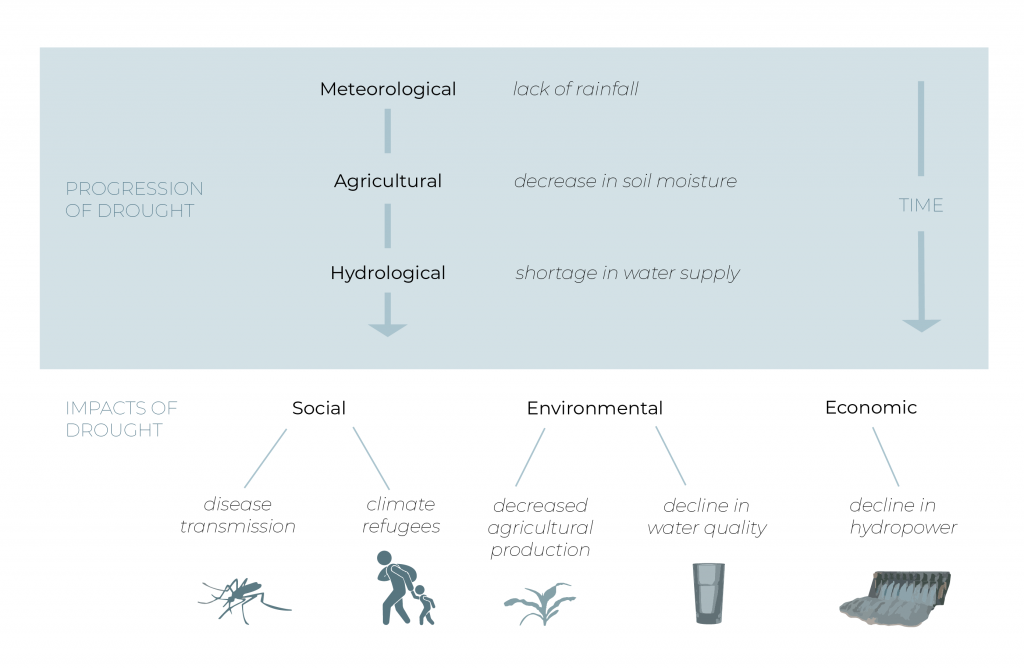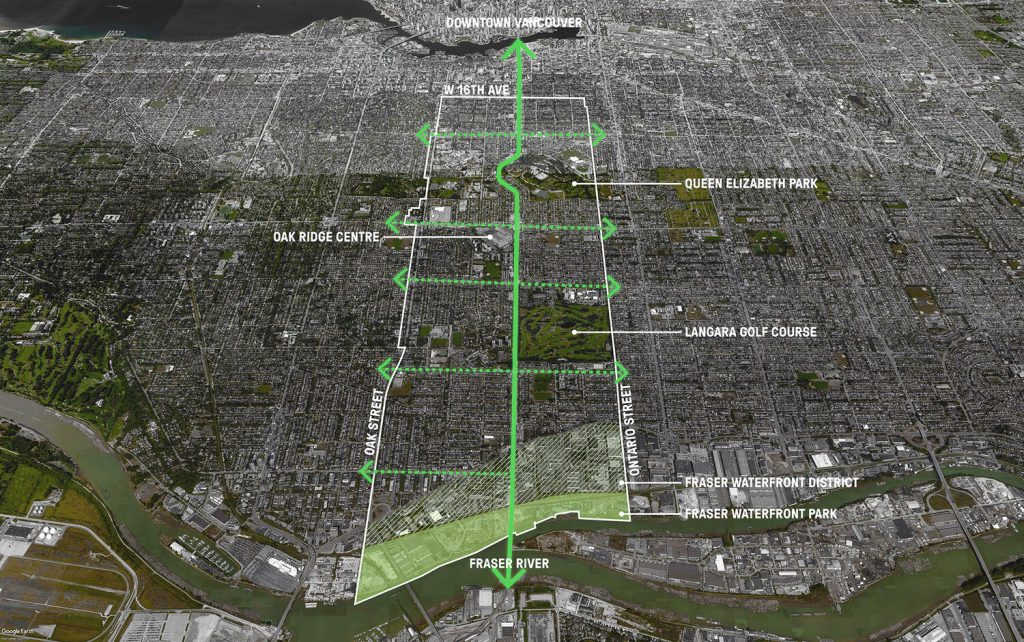In the 2022 Global Natural Disaster Assessment Report, the natural disaster affecting the highest percentage of people were droughts, with over 100 million people impacted and thousands of fatalities as a result1. According to the WHO, up to 700 million people may be at risk of displacement due to droughts by the year 20302. Across the globe, the impacts of droughts are increasing. In developing nations in particular, droughts have tremendous consequences, as they can lead to famines and political instability3.
[1] “2022 Global Natural Disaster Assessment Report | PreventionWeb.”
[2] “Drought.”
[3] Quiring, “HYDROLOGY, FLOODS AND DROUGHTS | Drought.”
How do droughts occur?
Droughts are a result of a decrease in normal levels of precipitation over varying time and spatial scales, resulting in a water shortage that is relative to the normal levels in the identified extent. The time scale may range from short-term events that last mere weeks to droughts that last for years or decades. The spatial scale is equally wide-ranging as droughts can be community-specific and small in scale or they can span across continents1. The decrease in precipitation that elicits droughts can be compounded by the impacts from water usage, distribution, planning, and management, thus increasing their severity2. The susceptibility to drought is increasing due to a varying climate and a growing human population, which puts demands on water for consumption, industrial usage, and agriculture, amongst other various uses3.
Within a broader definition of drought are the following further classifications: meteorological droughts, agricultural droughts, hydrological droughts, and socioeconomic droughts.
Meteorological droughts derive from a stretch of unusually dry weather, resulting in a hydrologic imbalance. They are measured or characterized by the intensity and duration of dryness4,5.
Agricultural droughts occur when a shortage of precipitation negatively impacts the crop production. Agriculture is the first system to be impacted due to a decrease in soil moisture and is thus measured and influenced by a deficit in precipitation, evapotranspiration, and soil moisture6.
When there are prolonged periods of a precipitation shortage, a hydrological drought may occur. These droughts are associated with a shortage of water in streams, lakes, reservoirs, and groundwater. As the water in reservoirs and rivers are used for many different purposes such as irrigation and power generation, it may be difficult to quantify the impacts of drought7.
Socioeconomic droughts occur when the water supply reaches a critical level that impacts human activities and ecosystem function. These droughts are concerned with the impact on supply and demand that is associated with the three previous drought categories8.
[1] Cook, Drought.
[2] Quiring, “HYDROLOGY, FLOODS AND DROUGHTS | Drought.”
[3] “Definition of Drought | 1 | Handbook of Drought and Water Scarcity | N.”
[4] Quiring, “HYDROLOGY, FLOODS AND DROUGHTS | Drought.”
[5] “Definition of Drought | 1 | Handbook of Drought and Water Scarcity | N.”
[6] Quiring, “HYDROLOGY, FLOODS AND DROUGHTS | Drought.”
[7] Quiring.
[8] “Definition of Drought | 1 | Handbook of Drought and Water Scarcity | N.”
What are the impacts of droughts?
The impacts of droughts are far-reaching, including a reduction in agricultural production, the formation of wildfires, the destruction of plants and habitats, water shortages, the restriction of waterways for navigation and recreation, and a loss of ecosystem services1. Extensive droughts can lead to desertification2. Other impacts include economic costs, as declines in hydropower production requires the generation of power from other sources, thus increasing the associated costs3. With these impacts, also comes larger political issues such as conflict amongst regions for water usage, social unrest, civil strife, and climate refugees4.
Health impacts
Droughts have a significant impact on human health overall, stemming from a shortage of drinking water, decline in water quality, effects on air quality and sanitation and hygiene, shortage of food, the increase in virus transmission, as seen in California with the West Nile virus, and even fatalities5.
Water quality. Water shortages may prompt a reduction in stream flow, thus increasing the concentration of pollutants, chemical, or human pathogens in aquatic organisms, or leading to higher temperatures and reduced oxygen levels6. An increase in precipitation following this may cause the release of this water, resulting in chemical pollution7.
Air quality. With an increase in the consequences of droughts, such as wildfires, comes an increase in the particulates within air, irritating the lungs and contributing to respiratory infections. As water levels change, an increase in freshwater blooms may also occur, also negatively impacting air quality8.
Disease Transmission. As the behaviours of insects and animals change, they may come into closer contact with humans, putting people at risk of contracting the diseases they carry9.
Malnutrition. This stems from a drop in agricultural productivity, leading to increased price of foods and reduced food security10.

[1] Cook, Drought.
[2] Panikkar, “Drought Management in an Urban Context.”
[3] Cook, Drought.
[4] Quiring, “HYDROLOGY, FLOODS AND DROUGHTS | Drought.”
[5] “Health Implications of Drought | CDC.”
[6] “Health Implications of Drought | CDC.”
[7] Panikkar, “Drought Management in an Urban Context.”
[8] “Health Implications of Drought | CDC.”
[9] “Health Implications of Drought | CDC.”
[10] IPCC, “Climate Change 2023 Synthesis Report.”
What are the ways designers can help prevent droughts from occurring or limit their severity?
There are a few ways that designers can intervene to help conserve and reuse water and improve the quality of water as well.
Restoration of wetlands, peatlands, and upstream forest ecosystems. These ecosystems enhance natural water retention and improve water quality1.
Reduction of impermeable surfaces. As impermeable surfaces do not allow for the infiltration of rainwater, it is best to reduce the area of impermeable surfaces and increase the total planted area as this supports groundwater recharge2.
Native planting. Since native plants are better adapted to local conditions, they often require less watering and require less maintenance or chemical intervention (fertilizers and pesticides)3.
Rainwater harvesting. This allows water within a building, landscape, or region to be reused to conserve potable water, and provide water in times of drought. Within a building, blue-green roofs provide water storage below the soil layer to then evaporate or to be used for the water requirements within the building or surrounding landscape4.
Agroforestry. This is a practice in which trees are grown on the same plot as ground crops as a means of increasing soil moisture and rainwater infiltration and reducing the demand on irrigation5,6.
Irrigation. While methods such as basin irrigation may reduce drought risk, it must be effectively managed as it has the potential to accelerate the depletion of groundwater7,8.
Living roofs (Green roofs). Green roofs act to reduce stormwater runoff, storing precipitation for subsequent evapotranspiration, and ultimately acting as retention and detention areas. Green roofs are one method of introducing LID (Low Impact Development) into the urban environment9. A more detailed explanation of the role of green roofs can be found here.
[1] IPCC.
[2] Watson and Adams, Design for Flooding : Architecture, Landscape, and Urban Design for Resilience to Climate Change.
[3] Watson and Adams.
[4] Watson and Adams.
[5] IPCC, “Climate Change 2023 Synthesis Report.”
[6] “5 Ways to Deal with Drought in Africa and Beyond.”
[7] IPCC, “Climate Change 2023 Synthesis Report.”
[8] “Definition of Drought | 1 | Handbook of Drought and Water Scarcity | N.”
[9] Roehr and Fassman-Beck, Living Roofs in Integrated Urban Water Systems.
Sources
“5 Ways to Deal with Drought in Africa and Beyond.” https://www.afd.fr/en/actualites/5-ways-deal-drought-africa-and-beyond.
“2022 Global Natural Disaster Assessment Report | PreventionWeb.” https://www.preventionweb.net/publication/2022-global-natural-disaster-assessment-report.
Cook, Ben. Drought. Columbia University Press, 2019. https://www.degruyter.com/document/doi/10.7312/cook17688/html?_llca=transfer%3A77f9860664252c29c25049871821c66a&_llch=9c98ee42f177768cbd03920610962bba76f4ac27273585ec85754bdcd4e62550.
“Definition of Drought | 1 | Handbook of Drought and Water Scarcity | N.” https://www.taylorfrancis.com/chapters/edit/10.1201/9781315404219-1/definition-drought-neil-coles-saeid-eslamian?context=ubx&refId=23a84fd7-6dcb-47ff-acfa-daf0da1da4c2.
“Drought.” https://www.who.int/health-topics/drought.
“Health Implications of Drought | CDC.” https://www.cdc.gov/nceh/drought/implications.htm.
IPCC. “Climate Change 2023 Synthesis Report,” 2023. https://www.ipcc.ch/report/ar6/syr/.
Panikkar, Avanish K. “Drought Management in an Urban Context.” Griffith University, n.d.
Quiring, S. “HYDROLOGY, FLOODS AND DROUGHTS | Drought.” In Encyclopedia of Atmospheric Sciences, 193–200. Elsevier, 2015. https://doi.org/10.1016/B978-0-12-382225-3.00037-2.
Roehr, Daniel, and Elizabeth Fassman-Beck. Living Roofs in Integrated Urban Water Systems. London, UNITED KINGDOM: Taylor & Francis Group, 2015. http://ebookcentral.proquest.com/lib/ubc/detail.action?docID=1983421.
Watson, Donald, and Michele Adams. Design for Flooding : Architecture, Landscape, and Urban Design for Resilience to Climate Change. John Wiley & Sons, 2010. https://ebookcentral.proquest.com/lib/ubc/reader.action?docID=624403&ppg=20#.
Additional resources
Precedents
Houston Arboretum
Location: Houston, Texas

“By removing trees and restoring the original prairie, savannah, and woodland ecosystems found at the Arboretum, the landscape architects designed a landscape naturally resilient to future climate shocks, such as more frequent and severe hurricanes, flooding, and drought.”
This project can be viewed on ASLA and the Arboretum website.
Cambie Corridor
Location: Vancouver, Canada

“The approach aims to integrate green infrastructure solutions that reduce water consumption and encourages re-use at a local scale, while counteracting climate change impacts such as drought and urban heating, and minimizing polluted overflows into the region’s waterbodies.”
This project is introduced here and the Cambie Corridor Plan can be accessed here.
